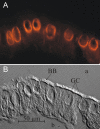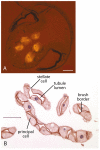Vacuolar-type proton pumps in insect epithelia
- PMID: 19448071
- PMCID: PMC2683008
- DOI: 10.1242/jeb.030007
Vacuolar-type proton pumps in insect epithelia
Abstract
Active transepithelial cation transport in insects was initially discovered in Malpighian tubules, and was subsequently also found in other epithelia such as salivary glands, labial glands, midgut and sensory sensilla. Today it appears to be established that the cation pump is a two-component system of a H(+)-transporting V-ATPase and a cation/nH(+) antiporter. After tracing the discovery of the V-ATPase as the energizer of K(+)/nH(+) antiport in the larval midgut of the tobacco hornworm Manduca sexta we show that research on the tobacco hornworm V-ATPase delivered important findings that emerged to be of general significance for our knowledge of V-ATPases, which are ubiquitous and highly conserved proton pumps. We then discuss the V-ATPase in Malpighian tubules of the fruitfly Drosophila melanogaster where the potential of post-genomic biology has been impressively illustrated. Finally we review an integrated physiological approach in Malpighian tubules of the yellow fever mosquito Aedes aegypti which shows that the V-ATPase delivers the energy for both transcellular and paracellular ion transport.
Figures





Similar articles
-
THE INSECT V-ATPase, A PLASMA MEMBRANE PROTON PUMP ENERGIZING SECONDARY ACTIVE TRANSPORT: IMMUNOLOGICAL EVIDENCE FOR THE OCCURRENCE OF A V-ATPase IN INSECT ION-TRANSPORTING EPITHELIA.J Exp Biol. 1992 Nov 1;172(Pt 1):345-354. doi: 10.1242/jeb.172.1.345. J Exp Biol. 1992. PMID: 9874747
-
The insect plasma membrane H+ V-ATPase: intra-, inter-, and supramolecular aspects.J Bioenerg Biomembr. 2003 Aug;35(4):359-66. doi: 10.1023/a:1025733016473. J Bioenerg Biomembr. 2003. PMID: 14635781 Review.
-
The V-type H(+)-ATPase in Malpighian tubules of Aedes aegypti: localization and activity.J Exp Biol. 2003 Jul;206(Pt 13):2211-9. doi: 10.1242/jeb.00385. J Exp Biol. 2003. PMID: 12771170
-
The insect V-ATPase, a plasma membrane proton pump energizing secondary active transport: molecular analysis of electrogenic potassium transport in the tobacco hornworm midgut.J Exp Biol. 1992 Nov;172:335-43. doi: 10.1242/jeb.172.1.335. J Exp Biol. 1992. PMID: 1491230 Review.
-
A vacuolar-type proton pump energizes K+/H+ antiport in an animal plasma membrane.J Biol Chem. 1991 Aug 15;266(23):15340-7. J Biol Chem. 1991. PMID: 1831202
Cited by
-
RNA interference as a gene silencing tool to control Tuta absoluta in tomato (Solanum lycopersicum).PeerJ. 2016 Dec 15;4:e2673. doi: 10.7717/peerj.2673. eCollection 2016. PeerJ. 2016. PMID: 27994959 Free PMC article.
-
The Toxicogenome of Hyalella azteca: A Model for Sediment Ecotoxicology and Evolutionary Toxicology.Environ Sci Technol. 2018 May 15;52(10):6009-6022. doi: 10.1021/acs.est.8b00837. Epub 2018 Apr 24. Environ Sci Technol. 2018. PMID: 29634279 Free PMC article.
-
Oral delivery of double-stranded RNAs and siRNAs induces RNAi effects in the potato/tomato psyllid, Bactericerca cockerelli.PLoS One. 2011;6(11):e27736. doi: 10.1371/journal.pone.0027736. Epub 2011 Nov 16. PLoS One. 2011. PMID: 22110747 Free PMC article.
-
Pea Albumin 1 subunit b (PA1b), a promising bioinsecticide of plant origin.Toxins (Basel). 2011 Dec;3(12):1502-17. doi: 10.3390/toxins3121502. Epub 2011 Dec 8. Toxins (Basel). 2011. PMID: 22295174 Free PMC article. Review.
-
The physiological response of larval Chironomus riparius (Meigen) to abrupt brackish water exposure.J Comp Physiol B. 2011 Apr;181(3):343-52. doi: 10.1007/s00360-010-0526-2. J Comp Physiol B. 2011. PMID: 21061010
References
-
- Al Awqati, Q. (1978). H+ transport in urinary epithelia. Am. J. Physiol. 235, F77-F88. - PubMed
-
- Allan, A. K., Du, J., Davies, S. A. and Dow, J. A. (2005). Genome-wide survey of V-ATPase genes in Drosophila reveals a conserved renal phenotype for lethal alleles. Physiol. Genomics 22, 128-138. - PubMed
-
- Azuma, M., Harvey, W. R. and Wieczorek, H. (1995). Stoichiometry of K+/H+ antiport helps to explain extracellular pH 11 in a model epithelium. FEBS Lett. 361, 153-156. - PubMed
-
- Bertram, G. and Wessing, A. (1994). Intracellular pH regulation by the plasma membrane V-ATPase in Malpighian tubules of Drosophila larvae. J. Comp. Physiol. B 164, 238-246. - PubMed
-
- Bertram, G., Schleithoff, L., Zimmermann, P. and Wessing, A. (1991). Bafilomycin A1 is a potent inhibitor of urine formation by Malpighian tubules of Drosophila hydei: is a vacuolar-type ATPase involved in ion and fluid secretion? J. Insect Physiol. 37, 201-209.
Publication types
MeSH terms
Substances
Grants and funding
LinkOut - more resources
Full Text Sources
Other Literature Sources
Molecular Biology Databases

